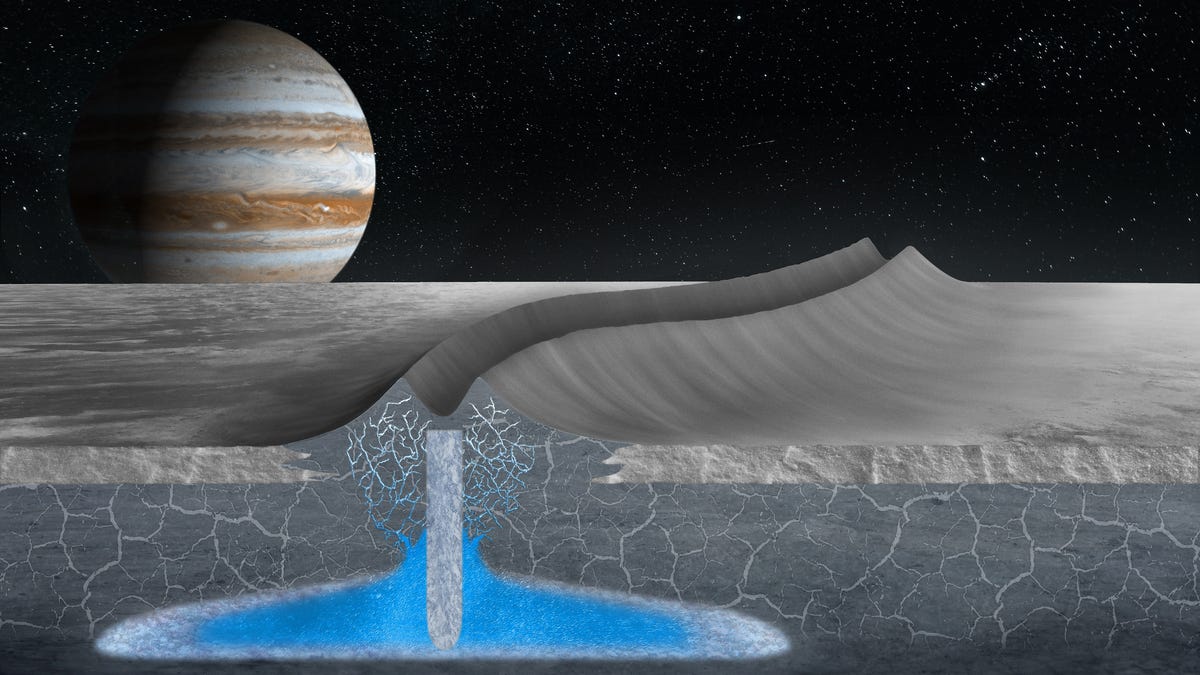New Data Tied to Jupiter Moon Europa Is Good News for Alien Believers
The frozen world has long been near the top of the list of places to look for alien life. It could be easier to check than we thought.

This artist's conception shows how double ridges on the surface of Jupiter's moon Europa may form over shallow, refreezing water pockets within the ice shell.
Jupiter's moon Europa hides a vast ocean that might support life, but it likely lies beneath an ice shell miles thick that makes it difficult to reach. Now, data from Greenland, of all places, suggests there may also be water just below Europa's surface.
The frozen landscape of the Jovian satellite is covered in icy double ridges that form a shape similar to the letter "M," but extend for as long as hundreds of miles. These double ridges crest at heights up to 1,000 feet (305 meters), separated by a trough in the middle as much as a half-mile (800 meters) wide.
The double ridge formations are ubiquitous on the surface of Europa. Almost since they were first spotted by the Galileo spacecraft in the 1990s, scientists have been hypothesizing about what forces might have formed them, suggesting everything from "ice wedges" built up over time to cryovolcanism (similar to regular volcanism, but with water and extreme cold rather than magma and extreme heat).
One idea holds that there may actually be water closer to the surface of Europa than first assumed, and it may be responsible for creating the distinctive double ridges. New research suggests this explanation is especially promising, because that's how very similar ridges are formed on Earth, in Greenland.
"In Greenland, this double ridge formed in a place where water from surface lakes and streams frequently drains into the near-surface and refreezes," Stanford Ph.D. student Riley Culberg said in statement.
Culberg is in a research group at Stanford that uses radio waves to study glaciers and other frozen terrain, both on Earth and elsewhere in the solar system. He said that when he heard a colleague mention the mystery of the double ridges on Europa, he recognized they resembled features in data from the Greenland Ice Sheet, which was collected through NASA's Operation IceBridge.
"We were working on something totally different related to climate change and its impact on the surface of Greenland when we saw these tiny double ridges -- and we were able to see the ridges go from 'not formed' to 'formed,' " Culberg's professor, Dustin Schroeder, said.
Culberg and Schroeder are co-authors on a study in the current issue of Nature Communications.
Schroeder says the revelation is exciting because the double ridges are so common on the surface of Europa and if they were formed the same way as the analogous ridges in Greenland, the moon might have a better chance of hosting life than previously thought.
"Because it's closer to the surface, where you get interesting chemicals from space, other moons and the volcanoes of Io, there's a possibility that life has a shot if there are pockets of water in the shell."
Europa also famously is home to giant geysers sometimes shooting water vapor into space. Understanding this world's dominant surface feature may also explain its other mysteries.
"We are making a much bigger step into the direction of understanding what processes actually dominate the physics and the dynamics of Europa's ice shell," said study co-author Gregor Steinbrügge, now a planetary scientist at NASA's Jet Propulsion Laboratory.
The real test of the notion that water may lie just beneath the surface on Europa will come when NASA's Europa Clipper mission takes a closer look at the moon than ever before. The robotic spacecraft is set to launch as soon as 2024, arriving at Jupiter in 2030.

